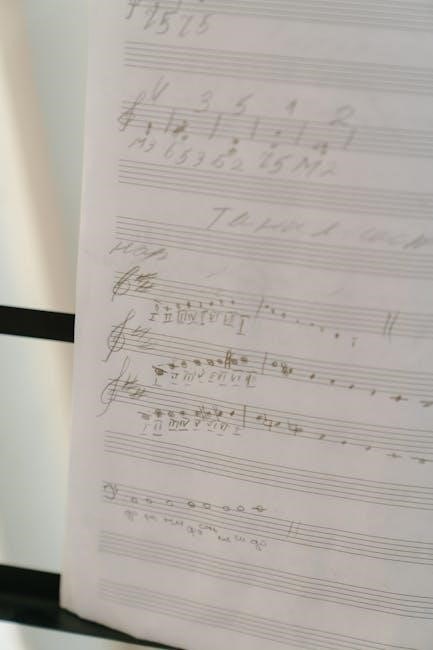
Converting PDF sheet music to MIDI enables musicians to transform static scores into editable digital files, enhancing creativity and collaboration. MIDI (Musical Instrument Digital Interface) allows precise control over musical elements, making it a powerful tool for composers and performers. This process bridges traditional sheet music with modern digital workflows, ensuring compatibility with electronic instruments and software. The conversion process involves recognizing musical notation and translating it into MIDI data, which can then be edited, rearranged, or performed using digital tools. This integration of PDF sheet music and MIDI technology has revolutionized music production, education, and performance, offering new opportunities for artistic expression and technical innovation.
What is MIDI?
MIDI (Musical Instrument Digital Interface) is a protocol enabling electronic musical instruments, computers, and related hardware to communicate. It transmits data like note timing, pitch, and velocity, allowing precise control over musical elements. Unlike audio files, MIDI doesn’t record sound but instructions for playback, making it versatile for editing and performance. Widely used in music production, MIDI bridges traditional notation and digital workflows, facilitating creativity and technical innovation in music technology.
What is Sheet Music?
Sheet music is a written representation of musical compositions, detailing pitches, rhythms, and other performance instructions. Traditionally printed on paper, it is now often distributed in digital formats like PDF. Sheet music serves as a universal language for musicians, enabling precise interpretation and execution of musical works. Whether for solo instruments or ensembles, it provides a visual framework for melody, harmony, and timing. Converting sheet music to MIDI transforms this static notation into an editable digital format, enhancing its utility in modern music production and collaboration.
Importance of Converting PDF Sheet Music to MIDI
Converting PDF sheet music to MIDI is essential for modern music production, as it transforms static scores into editable digital files. This process allows musicians to manipulate notes, rhythms, and harmonies with precision. MIDI files enable compatibility with digital instruments and software, fostering creativity and collaboration. By converting sheet music to MIDI, composers can easily rearrange, transpose, or enhance their works, making it a vital step in adapting traditional music to contemporary digital workflows and ensuring accessibility for future technological advancements.
Benefits of Converting PDF Sheet Music to MIDI
Converting PDF sheet music to MIDI offers enhanced editability, improved collaboration, and accessibility for digital instruments. It allows precise control over musical elements, fostering creativity and innovation in music production and performance, making it an indispensable tool for modern musicians and composers.
Enhanced Editability
Converting PDF sheet music to MIDI unlocks unparalleled editing capabilities. With MIDI, musicians can modify notes, timing, tempo, and dynamics effortlessly. Tools like PlayScore 2 and PDFtoMusic enable precise adjustments, allowing for personalized arrangements and creative tweaking. This flexibility transforms static sheet music into a dynamic, adaptable format, empowering composers and performers to refine their work with ease. The ability to edit individual elements ensures that MIDI files remain versatile for rehearsals, performances, and collaborative projects, making it an essential tool for modern music production.
Improved Collaboration
Converting PDF sheet music to MIDI significantly enhances collaboration among musicians and producers. MIDI files can be easily shared, edited, and interpreted by multiple parties, regardless of location. Tools like PlayScore 2 and MuseScore facilitate real-time feedback and adjustments, enabling seamless teamwork. MIDI’s universal compatibility allows artists to work together using different software, fostering creativity and efficiency. This digital format simplifies communication, ensuring all collaborators are on the same page, and makes it easier to integrate changes and ideas into the final piece.
Accessibility for Digital Instruments
Converting PDF sheet music to MIDI makes compositions accessible to digital instruments, enabling playback and performance without traditional sheet music. MIDI files can be directly loaded onto synthesizers, drum machines, and virtual instruments, allowing artists to hear and experiment with their music instantly. This conversion also supports electronic performances, where digital instruments can replicate complex scores accurately. By bridging the gap between sheet music and digital tools, MIDI enhances the versatility and reach of musical compositions, making them accessible to a broader range of artists and audiences worldwide.

Manual vs. Automatic Conversion Methods
Manual conversion involves transcribing sheet music to MIDI note-by-note, offering precision but requiring time and expertise. Automatic methods use AI tools for faster results, though accuracy may vary.
Manual Conversion Techniques
Manual conversion involves transcribing sheet music into MIDI by hand, requiring meticulous note-by-note entry. This method is time-consuming but ensures high accuracy. Users import the PDF and manually input pitches, rhythms, and dynamics using software tools like MuseScore or PDFtoMusic. While labor-intensive, manual conversion allows for precise control, correcting errors and nuances lost in automatic processes. It’s ideal for complex scores or when high fidelity is essential, though it demands significant time and musical expertise to achieve professional-quality results.
Automatic Conversion Using AI Tools
Automatic conversion using AI tools streamlines the process of transforming PDF sheet music into MIDI files. Advanced algorithms recognize musical notation, accurately interpreting pitches, rhythms, and dynamics. Tools like PlayScore 2 and MuseScore leverage AI to deliver high-quality MIDI outputs quickly. These platforms process uploaded PDFs, converting them into editable digital formats. While fast and efficient, AI-based tools may occasionally miss nuances in complex scores, but they significantly reduce manual effort, enabling composers and musicians to focus on creativity and performance.

Popular Tools and Software for PDF to MIDI Conversion
Popular tools include PlayScore 2, PDFtoMusic, MuseScore, and ScanScore. These applications efficiently convert PDF sheet music to MIDI, offering accuracy and ease of use for musicians and composers.
PlayScore 2
PlayScore 2 is an affordable and highly accurate sheet music scanner that converts PDF files to MIDI quickly. It supports various file formats and offers a user-friendly interface, making it ideal for musicians and composers. The app scans sheet music and exports it as MIDI, allowing for easy editing and playback. Its precision in recognizing musical notes and symbols ensures high-quality conversion, making it a top choice for those seeking reliable PDF-to-MIDI solutions.
PDFtoMusic
PDFtoMusic is a powerful tool designed to convert PDF sheet music into MIDI files with high accuracy. Developed by Myriad Software, it supports both free and PRO versions, with the latter offering advanced features like MusicXML export. The software recognizes musical notation and converts it into editable MIDI data, enabling composers to rearrange and enhance their work. While it excels at handling standard scores, it may face challenges with complex layouts or handwritten notation, making it a reliable choice for most musical needs.
MuseScore
MuseScore is a versatile music notation software that supports PDF to MIDI conversion using the Audiveris engine. It allows users to import PDF sheet music, edit it, and export it as MIDI files. Known for its user-friendly interface, MuseScore is popular among composers, educators, and students. It offers robust tools for creating, editing, and sharing music, making it an excellent choice for both professionals and novices. Its ability to handle complex scores and export them as MIDI files adds to its appeal in the music production workflow.
ScanScore
ScanScore is a powerful tool designed to digitize sheet music, converting PDF files into MIDI, MusicXML, and audio formats. It supports both ensemble scores and piano sheet music, allowing for precise recognition of musical notation. With ScanScore, users can import PDFs, edit them, and export them into various formats for further use. The software also offers a free 14-day trial, making it accessible for musicians to explore its features. Its ability to handle complex scores and produce high-quality MIDI files makes it a valuable resource for composers, educators, and performers alike.
Best Practices for Accurate Conversion
Start with high-quality PDF files for better OCR accuracy. Adjust settings in conversion tools to optimize note recognition and timing. Ensure clean, legible sheet music for precise MIDI output.
High-Quality Input Files
Using high-quality PDF sheet music is crucial for accurate MIDI conversion. Ensure the PDF is clear, high-resolution, and free from blurriness or distortions. Avoid handwritten or poorly scanned files, as they may lead to errors in note recognition. Opt for PDFs created from professional notation software or high-quality scans. Proper formatting, such as consistent spacing and legible notation, also improves conversion accuracy. Clear input files help AI tools recognize notes, dynamics, and articulations more effectively, resulting in a more accurate MIDI output.
Adjusting Settings for Optimal Results
Adjusting settings during PDF to MIDI conversion ensures better accuracy. Choose the correct DPI (dots per inch) for scanning sheet music to maintain clarity. Selecting the right output format and adjusting recognition sensitivity can improve note detection. Customize settings like tempo, time signature, and instrument mapping to match your needs. Some tools allow tweaking OCR (Optical Character Recognition) settings for complex scores. Experimenting with these parameters helps achieve a more precise and musically accurate MIDI file, enhancing the overall quality of the conversion process.

Challenges and Limitations of PDF to MIDI Conversion
PDF to MIDI conversion faces challenges like complex sheet music recognition and nuances lost in automatic processing. Accurate detection of notes, dynamics, and layouts remains a significant limitation.
Complexity of Sheet Music Recognition
Sheet music recognition involves interpreting complex musical notation, including notes, dynamics, and layouts, which can be challenging for conversion tools. Handwritten scores or intricate compositions often lead to inaccuracies. PDF files with poor quality or unconventional formatting may confuse OCR systems, resulting in errors. Advanced tools like PlayScore 2 and PDFtoMusic strive to improve accuracy, but complex arrangements, such as multi-instrument scores, still pose difficulties. This highlights the need for high-quality input and manual adjustments for optimal results in PDF-to-MIDI conversion.
Loss of Nuance in Automatic Conversion
Automatic conversion tools often struggle to capture the subtle nuances of sheet music, such as dynamics, articulations, and expressive markings. Complex layouts, handwritten annotations, or unconventional notation may not be accurately interpreted, leading to a loss of musical detail. While AI-powered tools like PlayScore 2 and PDFtoMusic improve accuracy, they may fail to replicate the precision of manual transcription, especially in intricate compositions. This limitation underscores the need for human oversight to refine and correct automatically generated MIDI files for faithful musical representation.

Future Trends in Music Technology
Advancements in AI and machine learning will enhance MIDI conversion accuracy, enabling real-time collaboration and personalized music creation. Integration with emerging digital instruments will expand creative possibilities, fostering innovation in music production and performance. These technologies promise to bridge gaps between traditional sheet music and modern digital workflows, offering unprecedented opportunities for musicians and composers to explore new sonic landscapes and artistic expressions.
Advancements in AI-Based Conversion Tools
AI-based conversion tools are transforming PDF sheet music to MIDI with unprecedented accuracy and efficiency. Advanced algorithms now recognize complex musical notation, dynamics, and articulations with precision, reducing errors and enhancing output quality. These tools, such as PlayScore 2 and MuseScore, leverage machine learning to improve conversion speed and fidelity, making them indispensable for musicians and composers. As AI evolves, real-time collaboration and automated adjustments will further streamline the process, ensuring seamless integration of sheet music into digital workflows.
Integration with Emerging Digital Instruments
MIDI files created from PDF sheet music seamlessly integrate with emerging digital instruments, enabling artists to explore new sonic possibilities. Tools like PlayScore 2 and MuseScore allow direct export to MIDI, which can then be used with synthesizers, drum machines, and virtual pianos. This integration enhances creativity, offering real-time editing and performance capabilities. As digital instruments evolve, MIDI remains a cornerstone, ensuring compatibility and accessibility for musicians. This synergy between traditional sheet music and modern technology continues to redefine music production and performance.
Converting PDF sheet music to MIDI unlocks new creative possibilities for musicians and composers. By leveraging advanced tools like PlayScore 2 and MuseScore, artists can easily transform static scores into editable MIDI files, enabling enhanced collaboration and accessibility. This process bridges the gap between traditional sheet music and modern digital instruments, ensuring that musical ideas can be expressed and shared with precision. As technology evolves, MIDI conversion remains a vital tool, empowering creators to bring their musical visions to life with greater ease and innovation.